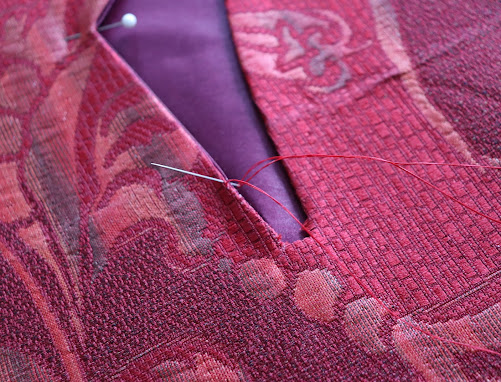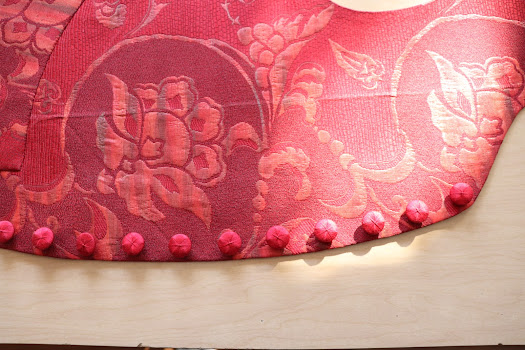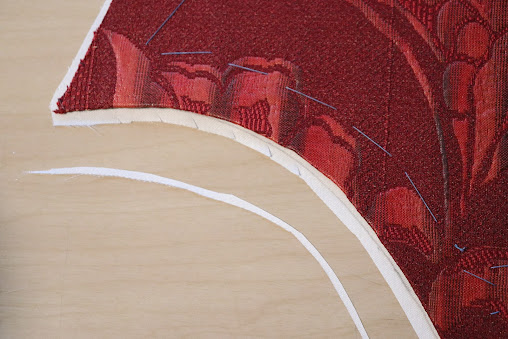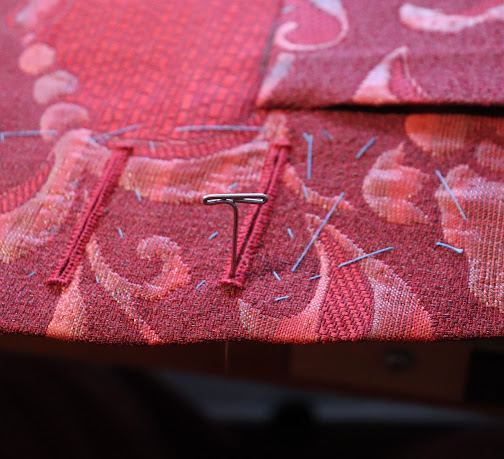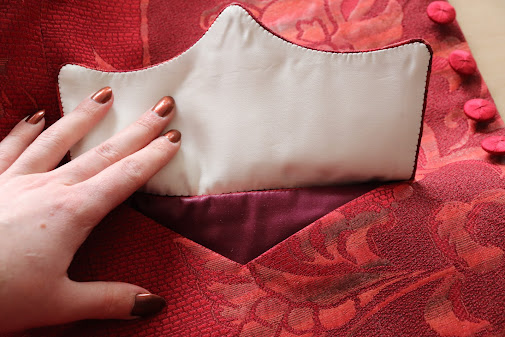(I say 1750's-ish because the fabric is a bit inaccurate looking, but only a bit.)
Last month I made a very long post about secondhand obi silk and, since I wanted a more precise idea of how much fabric my projects use for the measurement section, I ended up cutting out a waistcoat just to see. I've been wanting to get back to posting more often on this blog, so I decided I'd do a blog post about this one, and I remembered to photograph most (but not all) of the steps.
The fabric is, as I talked about in that post, a Nagoya obi that was 30 cm wide and had 2.56 m of brocade and 2 m of plainer basket weave textured silk. Some of the photos show a magenta tinge, but in person it's very red.While the design on it isn't perfectly accurate for 18th century, it has a similar enough look to some 18th century silks that I think it works nicely. The one thing I don't really like is how the floral parts have an ombre stripe to them.
I'm not sure what the striped material is either! The rest of it is silk, but the striped part is little flat strips similar to the metallic strips a lot of obi have, but they look and feel plastic-y and they burn like cotton. Perhaps some sort of large flat rayon filament? I do not know.
For the pattern I just used my jacket pattern, but without the sleeves. I somewhat regret this, as it's looser in the back than I would like, but I can always take it in.
There was just barely enough brocade for the fronts, and I had to cut the pocket flaps on the cross grain. |
| It means the stripes go in the wrong direction, but oh well. |
I originally planned to line it with this peachy orange satin that was the lining from another obi, but it turned out to be a silk/rayon blend that reacted weirdly to water.
I sprayed some water on it while ironing and it shrunk a dramatic amount, and then went back to the original size with some more ironing. After lining one pocket flap with it I decided a lining that behaves that way was a bad idea, so I recut it in plain white silk taffeta from my stash.
 |
| It's not showing up well here but it was very bent. |
I machine sewed the centre back seams on the back, and the back lining, and pressed the seams open. I also machine sewed the pocket bags.
 |
| I sewed the silk back pieces twice because it's so thick. |
 |
| (This is from after I sewed the buttons on, and you can see the additional button stand added later.) |
The buckram got warped from all the handling, so I pressed it after the buttonholes were done.
Always good to press things between steps!
I mark the corners of the pocket flap on the outside of the front, line it up and pin it, then baste it in place, and then carefully stab stitch the edge down to the front. The stitching goes a couple cm lower than the top corners of the pocket flap so it stays flat against the waistcoat.
 |
| The colours aren't coming across well in the photo but the linen matches even less in person. |
The button moulds I'm using are wooden spacer beads from aliexpress, because it turns out those are a lot better quality than the much more expensive reproduction ones I've bought in the past.
With the buttons & buttonholes all done it was time to line the fronts.
I laid the lining wrong side up on the table and lined up the waistcoat front on top of it. I pinned it in place and basted it on, making sure to leave a couple of cm open around the edges.
And making sure none of the basting got in the way of the buttonholes.
I trimmed the seam allowance (except on the side and shoulder seams) down to a little under a cm and clipped all the inward curves.
And folded it under and felled it down.
I then basted around the buttonholes individually, so as to keep the lining from shifting during the next steps.
I poked through the buttonholes from the outside with large pin to mark the ends on the lining side
and then cut through the lining along the length of the holes with my bird snips.
I whipstitched the cut edges down to the edges of the buttonhole.
(I show this method in my buttonhole video, as well as a fancier piecing method that provides a cleaner finish.)
At this point in the construction process I always lay my pattern piece back down on the fronts to re-trace the side and shoulder seam lines, because they're covered up by the lining and because the shape of the fronts often warps a bit from all the handling it's had.
 |
| Fronts both lined, button attachment stitching all nicely covered up. |
I often do that step by hand, but I did the sides and shoulders by machine because I wanted to make this waistcoat go slightly more quickly so I could get back to other stuff.
I always line up the centre back first, and then smooth out the halves one at a time. I clip the inward curves, fold the edges in, and pin them down.
I baste down all the edges so I can more easily sew the lining in without pins in the way, and also so I can try it on one last time before felling the edges.
It fit just fine, so I proceeded to fell down the lining edges. I used off white silk on the side and shoulder seams, and red cotton on the other edges.
Quite unnecessary to match the thread to the lining when the two halves of the lining don't even match and it's not going to be seen on the outside, but for some reason I just felt like matching it.
Then all that was left was to take out the basting and add bar tacks to the tops of all 3 vents.
Like the bar tacks on buttonholes, they're just a few long stitches taken across the surface, and then buttonhole stitches done over top.
 |
| Finished! |
There are a couple of little goo spots on the back hem that I must not have noticed when cutting out, because I did have enough of the plainer fabric to have avoided that.
Must have been tape or labels there. I'll try taking it off with goo-gone at some point.
Overall I'm very pleased with this waistcoat. It came together fairly quickly, I'm happy with the construction, and the fabric is fabulous.
However, it does fit quite loosely in the back, and I'm not sure if that'll be a problem yet because I don't currently have any coats that go with it. The fabric is so so stiff all around that the back wouldn't fold and rumple up in back if it were to be worn under a slightly too tight coat, it would bulge out weirdly in front.
 |
| Those shoe clips are not 18th century at all, but I had them and they matched and I'd never worn them before so I figured I may as well. |



















